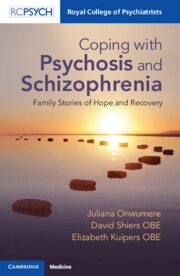2439 results
Understanding the mechanisms underlying cognitive control in psychosis
-
- Journal:
- Psychological Medicine , First View
- Published online by Cambridge University Press:
- 23 May 2024, pp. 1-10
-
- Article
-
- You have access
- Open access
- HTML
- Export citation
The management of patients with predominant negative symptoms in Slovakia: A 1-year longitudinal, prospective & multicentric cohort study
-
- Journal:
- European Psychiatry / Accepted manuscript
- Published online by Cambridge University Press:
- 23 May 2024, pp. 1-32
-
- Article
-
- You have access
- Open access
- Export citation
Chapter 8 - Mood and Psychosis: Limits and Overlapping between Psychotic Disorders and Mood Disorders
-
-
- Book:
- Clinical Textbook of Mood Disorders
- Published online:
- 16 May 2024
- Print publication:
- 23 May 2024, pp 82-94
-
- Chapter
- Export citation
Age-dependent association of cannabis use with risk of psychotic disorder
-
- Journal:
- Psychological Medicine , First View
- Published online by Cambridge University Press:
- 22 May 2024, pp. 1-11
-
- Article
-
- You have access
- Open access
- HTML
- Export citation

Coping with Psychosis and Schizophrenia
- Family Stories of Hope and Recovery
-
- Published online:
- 16 May 2024
- Print publication:
- 23 May 2024
Lipid-modifying agents and risk of all-cause, natural and suicide mortality in schizophrenia: nationwide cohort study
-
- Journal:
- The British Journal of Psychiatry , FirstView
- Published online by Cambridge University Press:
- 16 May 2024, pp. 1-9
-
- Article
- Export citation
Shared and distinct electroencephalogram microstate abnormalities across schizophrenia, bipolar disorder, and depression
-
- Journal:
- Psychological Medicine , First View
- Published online by Cambridge University Press:
- 13 May 2024, pp. 1-8
-
- Article
- Export citation
The contribution of cannabis use to the increased psychosis risk among minority ethnic groups in Europe
-
- Journal:
- Psychological Medicine , First View
- Published online by Cambridge University Press:
- 09 May 2024, pp. 1-10
-
- Article
-
- You have access
- Open access
- HTML
- Export citation
Association between childhood maltreatment and suicidal ideation among Chinese patients with chronic schizophrenia: the mediating role of insomnia
-
- Journal:
- BJPsych Open / Volume 10 / Issue 3 / May 2024
- Published online by Cambridge University Press:
- 03 May 2024, e98
-
- Article
-
- You have access
- Open access
- HTML
- Export citation
Case 7: - Where did her period go?
-
-
- Book:
- Case Studies: Stahl's Essential Psychopharmacology
- Published online:
- 03 April 2024
- Print publication:
- 18 April 2024, pp 109-132
-
- Chapter
- Export citation
Case 6: - The man whom clozapine (Clozaril) could not touch
-
-
- Book:
- Case Studies: Stahl's Essential Psychopharmacology
- Published online:
- 03 April 2024
- Print publication:
- 18 April 2024, pp 87-108
-
- Chapter
- Export citation
Case 3: - Propane, shattered glass, and parasites
-
-
- Book:
- Case Studies: Stahl's Essential Psychopharmacology
- Published online:
- 03 April 2024
- Print publication:
- 18 April 2024, pp 39-52
-
- Chapter
- Export citation
Chapter 5.4 - Psychosocial Management of Psychosis
-
-
- Book:
- Seminars in General Adult Psychiatry
- Published online:
- 04 April 2024
- Print publication:
- 18 April 2024, pp 282-292
-
- Chapter
- Export citation
Case 10: - Darth Vaper strikes again
-
-
- Book:
- Case Studies: Stahl's Essential Psychopharmacology
- Published online:
- 03 April 2024
- Print publication:
- 18 April 2024, pp 167-182
-
- Chapter
- Export citation
Chapter 5.2 - Causes and Outcome of Psychosis
-
-
- Book:
- Seminars in General Adult Psychiatry
- Published online:
- 04 April 2024
- Print publication:
- 18 April 2024, pp 224-240
-
- Chapter
- Export citation
Chapter 5.1 - Schizophrenia and Other Primary Psychoses
-
-
- Book:
- Seminars in General Adult Psychiatry
- Published online:
- 04 April 2024
- Print publication:
- 18 April 2024, pp 198-223
-
- Chapter
- Export citation
Psychosocial and psychological interventions for schizophrenia relapse prevention: A bibliometric analysis
-
- Journal:
- Cambridge Prisms: Global Mental Health / Volume 11 / 2024
- Published online by Cambridge University Press:
- 12 April 2024, e49
-
- Article
-
- You have access
- Open access
- HTML
- Export citation
The relationship between childhood trauma, psychotic symptoms, and cognitive schemas in patients with schizophrenia, their siblings, and healthy controls: results from the EU-GEI study
-
- Journal:
- Psychological Medicine , First View
- Published online by Cambridge University Press:
- 12 April 2024, pp. 1-12
-
- Article
-
- You have access
- Open access
- HTML
- Export citation
PsiOvi Staging Model for Schizophrenia (PsiOvi SMS): A New Internet Tool for Staging Patients with Schizophrenia
-
- Journal:
- European Psychiatry / Volume 67 / Issue 1 / 2024
- Published online by Cambridge University Press:
- 11 April 2024, e36
-
- Article
-
- You have access
- Open access
- HTML
- Export citation
Early auditory processing abnormalities alter individual learning trajectories and sensitivity to computerized cognitive training in schizophrenia
-
- Journal:
- Psychological Medicine , First View
- Published online by Cambridge University Press:
- 08 April 2024, pp. 1-8
-
- Article
- Export citation



